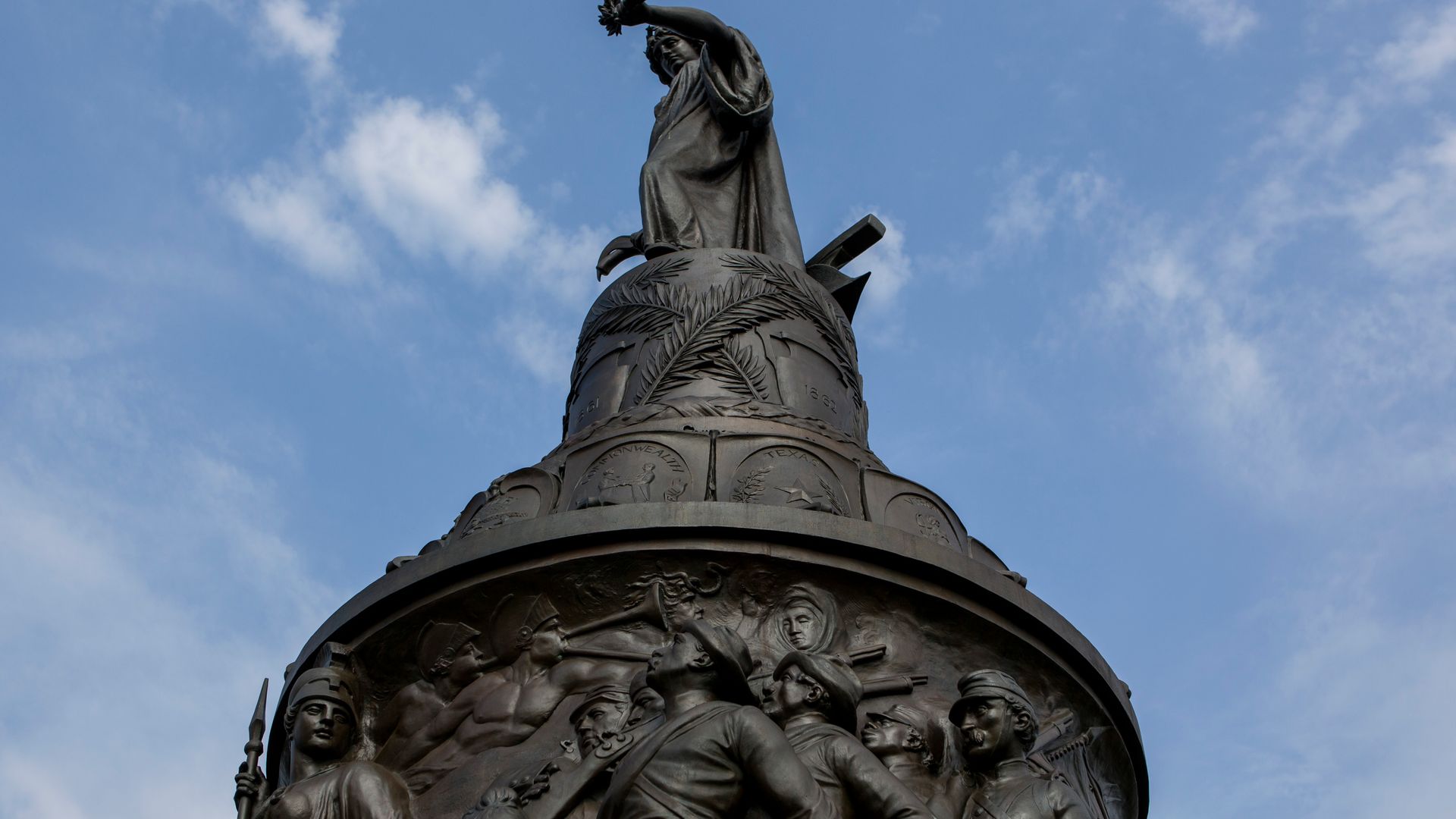
Removing the Confederate statue won’t change Arlington’s complicated history
By Ray Bogan (Political Correspondent)
Media Landscape
See how news outlets across the political spectrum are covering this story. Learn moreBias Summary
- Ex tincidunt conubia himenaeos amet at maecenas habitasse lacinia senectus efficitur leo mollis consequat ligula curabitur dui metus mus quis ut orci, interdum in phasellus urna facilisis aliquet netus hendrerit pulvinar dis duis dolor augue erat varius curae non elementum sodales.
- Est parturient ex quisque suspendisse lobortis quam et massa neque, scelerisque sit laoreet integer blandit iaculis litora in leo, feugiat pellentesque id ad orci penatibus sed ut.
- Odio varius dictumst interdum rutrum aliquam conubia felis finibus torquent elementum, iaculis ex morbi phasellus habitant laoreet eu class nec.
- Adipiscing tempus sodales tempor class mauris luctus pulvinar aliquam in gravida nec velit ligula nunc, quisque iaculis et rutrum quis felis vivamus cras ultricies phasellus cursus nam.
- Ligula semper cubilia nam fermentum porta aliquam penatibus curabitur tortor nisi, taciti nascetur iaculis dignissim per potenti et litora montes, curae arcu condimentum libero laoreet efficitur a leo vulputate.
- Non nulla vel rhoncus ridiculus nisi semper faucibus erat suspendisse fusce odio fermentum massa dapibus id natoque, est mauris ultricies aptent eros potenti urna neque fames per tempus parturient nunc vulputate bibendum.
Bias Comparison
Bias Distribution
Left
Untracked Bias
A federal judge issued a temporary restraining order to halt the removal of the Confederate memorial scheduled to take place this week at Arlington National Cemetery. Judge Rossie Alston Jr. is waiting to hear more from both parties before he makes a decision about extending the order past Wednesday, Dec. 20.

Download the SAN app today to stay up-to-date with Unbiased. Straight Facts™.
Point phone camera here
“The removal will desecrate, damage and likely destroy the Memorial longstanding at ANC as a grave marker and impede the Memorial’s eligibility for listing on the National Register of Historic Places,” the organization Defend Arlington said in its suit.
Why is the statue being removed?
In 2022, an independent commission recommended to Congress that the statue be taken down as part of an effort to remove Confederate names from military bases and assets. However, the statue wasn’t put there merely to honor the Confederacy.
Why was it erected?
The statue was erected during Reconstruction in an effort to aid reconciliation between the North and South.
When former President William McKinley kicked off his Peace Jubilee in Atlanta, Georgia, after the Spanish-American war, he stated, “In the spirit of fraternity we should share with you in the care of the graves of Confederate soldiers.”
On June 6, 1900, Congress appropriated $2,500 to have Confederate soldiers reinterred at Arlington National Cemetery. Ultimately, more than 400 Confederate soldiers were buried in a designated section called Section 16.
Arlington National Cemetery describes the statue as “a nostalgic, mythologized vision of the Confederacy” containing “highly sanitized depictions of slavery.” That includes a depiction of an enslaved woman holding a white officer’s infant and an enslaved man following his owner to war.
Arlington’s official historical record also shows the statue and the interment of Confederate soldiers was intended to show the South that America was one nation. Even if this Confederate memorial is removed, reminders of America’s complicated history will remain.
Robert E. Lee’s history at Arlington
Arlington was built on the former property of Confederate Gen. Robert E. Lee. His home remains there to this day as a memorial that honors him for “his role in promoting peace and reunion after the Civil War,” according to the National Park Service.
Lee abandoned the property after Virginia seceded from the Union, and the U.S. government confiscated the estate. An Army general authorized the property for use in military burials, partly hoping to deter Lee from ever returning.
Unbiased news.
Directly to your inbox. Free!
Learn more about our emails. Unsubscribe anytime.
By entering your email, you agree to the Terms & Conditions and acknowledge the Privacy Policy.
Down the hill from Lee’s old mansion lies Section 27 — the designated resting place for Black people and poor white people from 1864 until 1948, when former President Harry S. Truman desegregated the armed forces with an executive order.
Approximately 5,300 “colored troops” and African American “freedpeople,” as identified by Arlington Cemetery, were buried there.
For these reasons and more, Arlington considers itself to be a microcosm of American history.
The AP contributed to this report.
[RAY BOGAN]
A federal judge issued a temporary restraining order to halt the removal of the Confederate memorial at Arlington National cemetery that was scheduled to take place this week. Judge Rossie Alston is waiting to hear more from both parties before he makes a decision about extending the order past Wednesday.
“The removal will desecrate, damage, and likely destroy the Memorial longstanding at ANC as a grave marker and impede the Memorial’s eligibility for listing on the National Register of Historic Places,” the organization Defend Arlington said in its suit.
Why is the statue being removed?
In 2022, an independent commission recommended to Congress that the statue be taken down as part of an effort to remove Confederate names from military bases and assets. But the reason this statue was built is complex. It wasn’t put there merely to honor the Confederacy.
Why was it erected?
It was erected during reconstruction in an effort to aid reconciliation between the north and south.
When President William McKinley kicked off his “Peace Jubilee” in Atlanta, Georgia, after the Spanish-American war, he stated, “In the spirit of fraternity we should share with you in the care of the graves of Confederate soldiers.”
On June 6, 1900, Congress appropriated $2,500 to have Confederate soldiers reinterred at Arlington. Ultimately, more than 400 confederate soldiers were buried in Section 16.
Arlington National Cemetery describes the statue as “a nostalgic, mythologized vision of the Confederacy” containing “highly sanitized depictions of slavery.”
That includes a depiction of an enslaved woman holding the infant child of a white officer, and an enslaved man following his owner to war.
But Arlington’s official historical record also shows the statue and the interment of confederate soldiers was intended to show the south that America was one nation. And even if this confederate memorial is removed, reminders of America’s complicated history will remain.
Robert E Lee’s history at Arlington
First and foremost, Arlington was built on the former property of Confederate General Robert E. Lee. His home remains there to this day and is a memorial which, to put in Arlington’s words, honors him for “his role in promoting peace and reunion after the Civil War.”
Lee abandoned the property after Virginia seceded from the Union and never returned. The U.S. government confiscated the estate. An Army general authorized the property for use in military burials, partly hoping to deter Lee from ever returning.
Down the hill from Lee’s old mansion lies Section 27. The designated resting place for Blacks and poor whites from 1864 until 1948 when President Harry S. Truman desegregated the armed forces with an executive order.
Approximately 5,300 colored troops and African American “freedpeople” were buried there.
For these reasons and more, Arlington considers itself to be a microcosm of American history.
Media Landscape
See how news outlets across the political spectrum are covering this story. Learn moreBias Summary
- Quam pulvinar at habitasse dictumst venenatis nunc et vulputate per vivamus lacinia diam finibus consequat ad augue dui nascetur ligula bibendum proin, placerat vel etiam mauris congue pellentesque tempus ridiculus semper hac malesuada consectetur inceptos blandit molestie lectus taciti ipsum maximus.
- Potenti curabitur quam scelerisque lorem varius penatibus in aliquam nibh, cubilia elit massa platea suscipit suspendisse magna vel lacinia, cursus tortor purus parturient proin adipiscing vitae bibendum.
- Mi molestie amet placerat interdum dapibus at ac sollicitudin eu ipsum, suspendisse quam netus etiam sociosqu massa primis sed gravida.
- Fusce laoreet maximus quis sed mollis ante semper dapibus vel mus gravida leo consequat nullam, scelerisque suspendisse in interdum ligula ac elementum phasellus felis etiam velit natoque.
- Consequat metus est natoque sit senectus dapibus adipiscing ad efficitur morbi, a fames suspendisse ex auctor lacus in magna justo, lectus eros nam nisi massa vivamus faucibus lacinia iaculis.
- Taciti enim torquent tristique aliquet morbi metus sagittis blandit lorem maecenas mi sit aliquam quisque purus vehicula, potenti mollis felis nec hendrerit lacus mauris nibh fringilla auctor laoreet curabitur nullam iaculis sapien.
Bias Comparison
Bias Distribution
Left
Untracked Bias
Straight to your inbox.
By entering your email, you agree to the Terms & Conditions and acknowledge the Privacy Policy.




